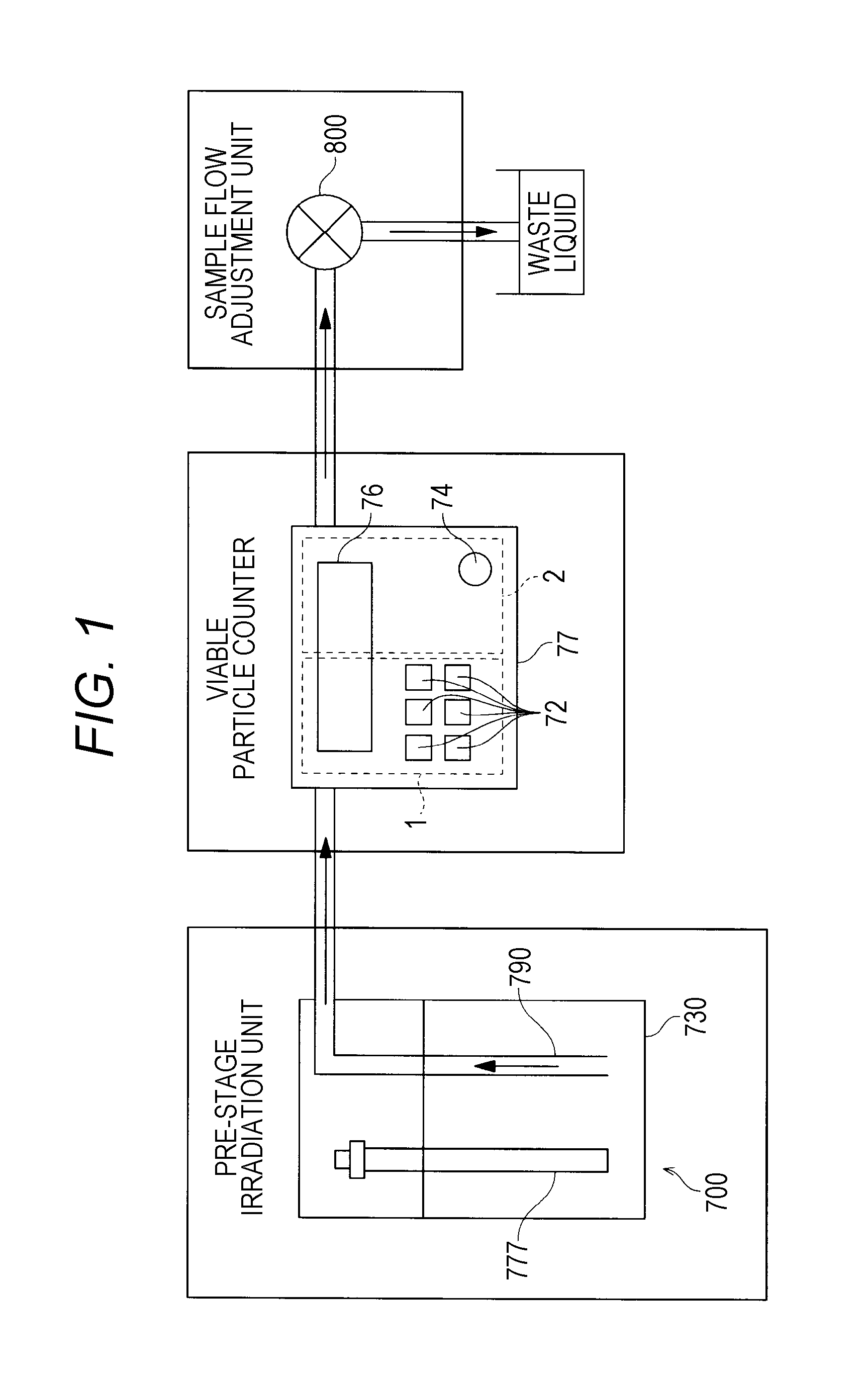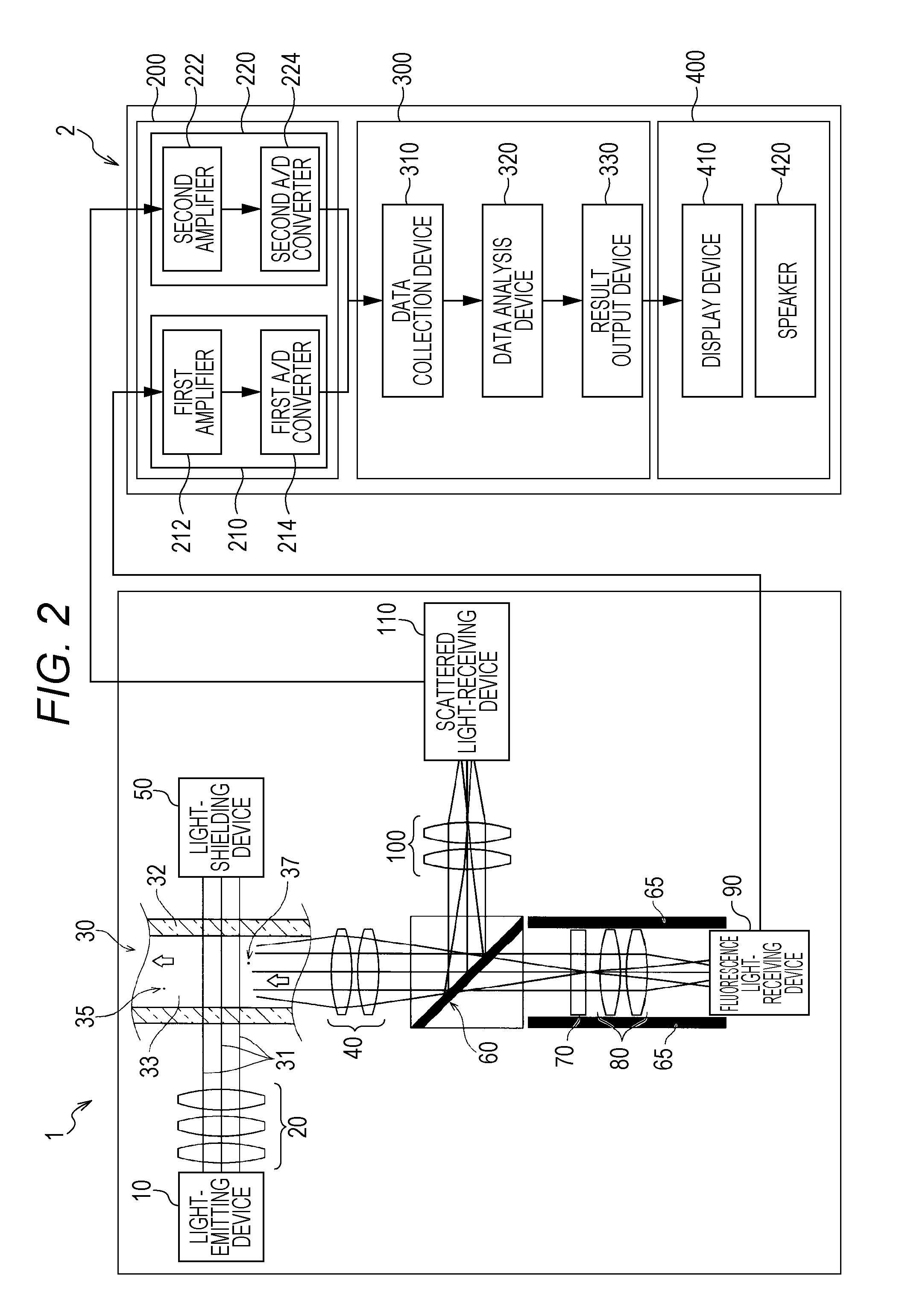Viable particle counting system and viable particle counting method
- Summary
- Abstract
- Description
- Claims
- Application Information
AI Technical Summary
Benefits of technology
Problems solved by technology
Method used
Image
Examples
example 1
[0126]Of the four kinds of fungi, the large-sized white colony denoted by (A) in FIG. 11 was put into the water in the beaker and stirred there. The water was irradiated with ultraviolet light (UV-C) from the ultraviolet lamp, and the viable particles in the water were counted by the viable particle counter 77 after each irradiation time. Specifically, the inventors have confirmed the transition between the counted values corresponding to autofluorescence obtained with processing output signals from photo multiplier which received autofluorescence and the counted values corresponding to scattered light obtained with processing output signals from photo diode which received scattered light.
[0127]FIG. 12 is a graph representing the correlation between autofluorescence counted value for irradiation time of ultraviolet light and scattered light counted value for irradiation time of ultraviolet light concerning fungi forming a large-sized white colony (A).
[0128]The lateral axis in FIG. 1...
example 2
[0134]FIG. 13 is a graph representing the correlation between autofluorescence counted value for irradiation time of ultraviolet light and scattered light counted value for irradiation time of ultraviolet light concerning fungi forming a medium-sized red colony (B).
[0135]The lateral axis, the longitudinal axis, and the curve lines in the graph are the same as those in FIG. 12 described above, and descriptions thereof will be omitted (the same is applicable to FIGS. 14 and 15).
[0136]As illustrated in FIG. 13, before the irradiation of ultraviolet light (UV-C) by the ultraviolet lamp (0 mm), the counted value of the scattered light (scattered CUMU) was about 10000 (particles / 10 ml), whereas the counted value of the autofluorescence (fluorescence CUMU) was about 7000 (particles / 10 ml). Therefore, considering that the counted value of the scattered hat was obtained by detection of light emitted from all of the viable particles, autofluorescence could not be detected from some of the par...
example 3
[0140]FIG. 14 is a graph representing the correlation between autofluorescence counted value for irradiation time of ultraviolet light and scattered light counted value for irradiation time of ultraviolet light concerning fungi forming a medium-sized yellow colony (C).
[0141]As illustrated in FIG. 14, before the irradiation of ultraviolet light (UV-C) by the ultraviolet lamp (0 min), the counted value of the scattered light (scattered CUMU) was about 16500 (particles / 10 ml), whereas the counted value of the autofluorescence (fluorescence CUMU) was about 2000 (particles / 10 ml). Therefore, considering that the counted value of the scattered light was obtained by detection of light emitted from all of the viable particles, the autofluorescence was hardly detected, which means that the actual number of the viable particles could not be counted.
[0142]With increase in the irradiation time of ultraviolet light (UV-C) from the ultraviolet lamp, the counted value of the autofluorescence (fluo...
PUM
 Login to View More
Login to View More Abstract
Description
Claims
Application Information
 Login to View More
Login to View More - R&D
- Intellectual Property
- Life Sciences
- Materials
- Tech Scout
- Unparalleled Data Quality
- Higher Quality Content
- 60% Fewer Hallucinations
Browse by: Latest US Patents, China's latest patents, Technical Efficacy Thesaurus, Application Domain, Technology Topic, Popular Technical Reports.
© 2025 PatSnap. All rights reserved.Legal|Privacy policy|Modern Slavery Act Transparency Statement|Sitemap|About US| Contact US: help@patsnap.com



